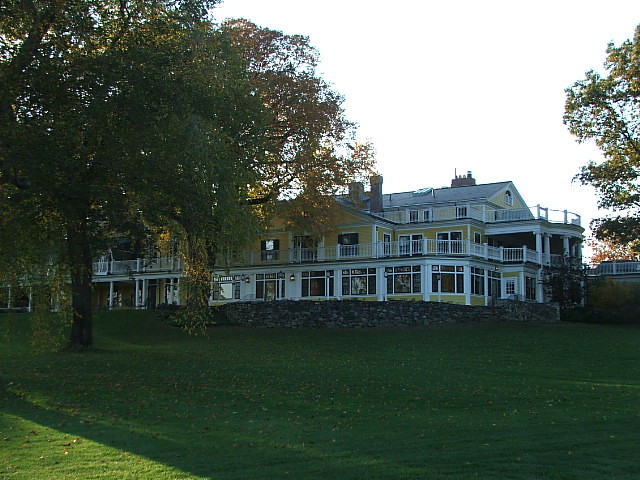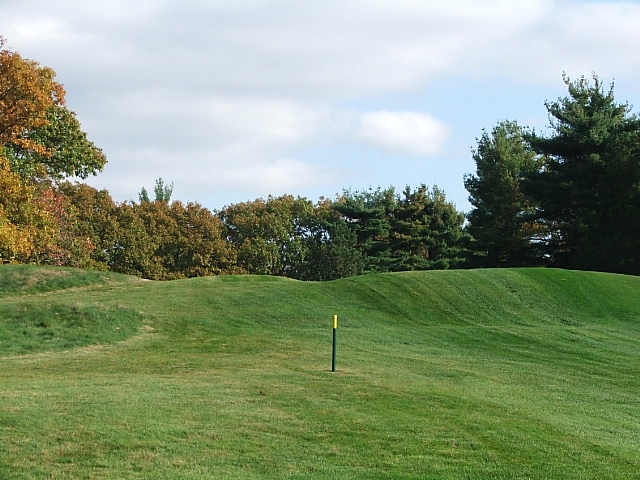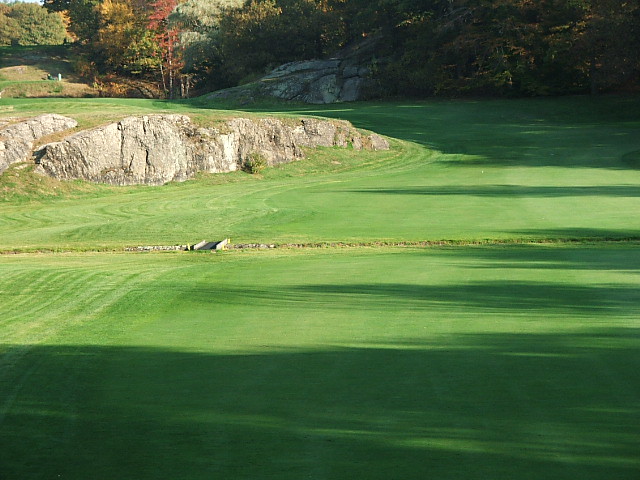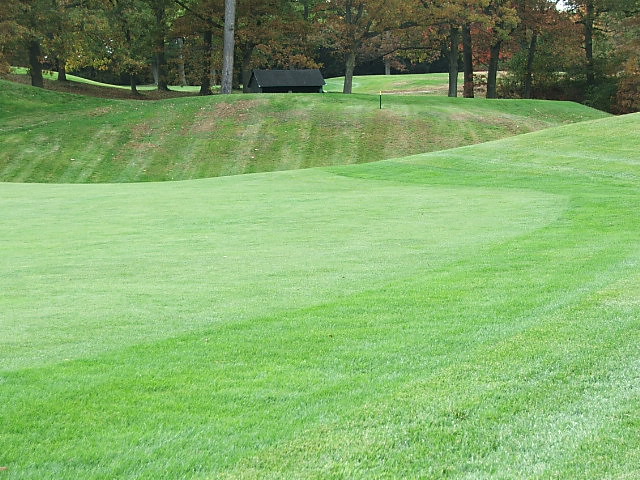

As you continue down the entry road (you are crossing the 15th fairway between Woody and the clubhouse) you come upon one of the most beautiful clubhouses in the golf world, which fits perfectly into the landscape with its beautiful ochre color.
The Country Club has a unique name not because they are pretentious but because they were the first country club in the U.S., and I would have to say that they did it right. It would be difficult to improve on anything they've done here. You approach the clubhouse around an oval driveway. Ahead of you is an old building that is the men's locker room. To your right are several other buildings - one used for curling, another houses the enclosed tennis courts, another for squash, etc. The place is a bee-hive of activity. Although it is only five miles from downtown Boston, when The Country Club was built it truly was a club located in the country with a variety of sporting activities including, originally, horse racing, which is no longer present. A club for all seasons, there is an ice skating pond with an associated club house down near the middle of the course.
The view from the 9th fairway
I was lucky enough to play The Country Club on a brilliant day, and it was very enjoyable. The course has the most varied routing I have ever seen. It follows the contours of the land and meanders its way around the property. More than a half dozen times I was surprised when the member or caddy pointed in the opposite direction of where I thought we were going to go to the next tee box. The course was designed by a variety of people; originally by Willie Campbell, with modifications by William Flynn, Geoff Cornish and Rees Jones with no singular influence being exerted. One of the features that you find throughout the course are the glacial rock formations that holes are routed through and around, such as the par five 11th hole, aptly called Himalayas, seen below. You hit your tee shot on this hole from a high, elevated tee to a crevice in the rock canyon on the left side of the fairway. Midway between the bottom of the canyon and the elevated green is a creek that runs through the bottom of the hole. Not the type of hole you see every day and one that really uses the geography present to maximum advantage.
Rocks from the last ice age feature prominently on the 11th hole
The terrain for the 18 holes is quite hilly and used to good effect, although it is not a terribly difficult course to walk. I know I am beating a drum on this topic, but I am again struck by how the world's great golf courses contain so many blind shots, which I really like. The #1 handicap hole, the third, seen below, is another case in point with a blind second shot to the green.
Blind second shot on the 3rd hole at The Country Club
View of the green, hole #3, from the fairway
The course also has a Redan hole, the short 12th, although it is a non-traditional version of the Redan. The hole plays from an elevated tee sharply down hill and is only 130 yards. Although it's not a typical Redan hole, I thought it was very good and guarded by a plethora of bunkers in the front. We had just completed playing the front nine and were walking down the hill back toward the tenth tee. The tenth and first tees essentially share the same very large tee box. If a group is teeing off on one tee box, good etiquette calls for you to wait for the other group to hit before you do so and vice versa.
As we were coming down the hill there were about 15 young golfers mingling around by the first tee, all wearing khakis and crimson polo shirts. As we approached, I noted that they all looked perfect. Perfectly fit, perfectly groomed, good looking, confident and athletic. It was the Harvard golf team (men's and women's), with monogramed Harvard golf bags, who use The Country Club as their golf course. It really made me think how privileged they were. Let's see, you look like Richard Gere or Jennifer Aniston, you go to (arguably) the best college in the world, are athletic, smart and play on the golf team. Is it possible to have a brighter future? These kids have got life by the balls. If anyone has ever told you that life was fair, they were lying.I had a good caddy at The Country Club, although I had a tough time understanding him with his heavy Boston accent. After my drive on the first hole I had "143 yaawds" to the green and somehow managed a "great paah" after missing the green.
The 17th hole at The Country Club is one of the most historic in the game. It is where Francis Ouimet won the playoff against Harry Vardon and Ted Ray in 1913 to pull off one of the biggest upsets in golf history by winning the U.S. Open at age 20 as an amateur, against two of the world's best. It is also the famous green where Justin Leonard made his monster putt during the 1999 Ryder Cup and then the Americans had the unseemly, but justified, celebration on the green. I would say that the green looks a lot different than it does on TV. The green is long and narrow and is two-tiered. The putt Leonard made is even more impressive to me now, having seen how much break there is, given the two tiers.
The greens at The Country Club are all small. Along with Inverness and Pebble Beach, among the smallest in championship golf. Another unique feature of the course are the small chocolate-drop style mounds that are present around some of the greens. They force you to play from an uneven lie as a penalty for a missed green.
Like other turn-of-the-century clubs, The Country Club jealously guards the traditions of the game, thankfully. The Country Club is an old-school place to play. Like at Oakmont, you need a medical exemption to take a cart. They believe, rightly, that you should walk if you can. This policy also has the positive impact of allowing them to continue to support the noble profession of caddying.
Truth be told, Boston is not one of my favorite cities. I have always found it a bit uptight and stuffy. I was pleasantly surprised by my experience in Brookline. The club is family oriented, welcoming and not pretentious. Sitting in the dining room is a treat since the place drips with history. Most of the women sitting having lunch the day I was there were modeled after Julia Child: big-boned, elegant and proper. I also noted more than a fair share of men wearing bow ties at the club. No doubt, they still have a number of Boston Brahmins around with names like Saltonstall, Cabot, Peabody and Putnam!
The idyllic setting at The Country Club
"To me, the property around here is hallowed. The grass grows greener, the trees bloom better, there is even warmth in the rocks. And I don't know...but somehow or other the sun seems to shine brighter on The Country Club than on any other place that I have ever seen" -- Francis Ouimet






No comments:
Post a Comment